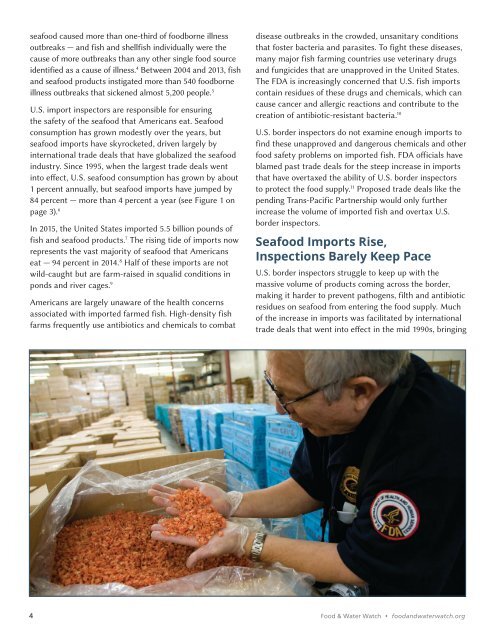TOXIC BUFFET
rpt_1609_tpp-fish-web
rpt_1609_tpp-fish-web
You also want an ePaper? Increase the reach of your titles
YUMPU automatically turns print PDFs into web optimized ePapers that Google loves.
seafood caused more than one-third of foodborne illness<br />
outbreaks — and fish and shellfish individually were the<br />
cause of more outbreaks than any other single food source<br />
identified as a cause of illness. 4 Between 2004 and 2013, fish<br />
and seafood products instigated more than 540 foodborne<br />
illness outbreaks that sickened almost 5,200 people. 5<br />
U.S. import inspectors are responsible for ensuring<br />
the safety of the seafood that Americans eat. Seafood<br />
consumption has grown modestly over the years, but<br />
seafood imports have skyrocketed, driven largely by<br />
international trade deals that have globalized the seafood<br />
industry. Since 1995, when the largest trade deals went<br />
into effect, U.S. seafood consumption has grown by about<br />
1 percent annually, but seafood imports have jumped by<br />
84 percent — more than 4 percent a year (see Figure 1 on<br />
page 3). 6<br />
In 2015, the United States imported 5.5 billion pounds of<br />
fish and seafood products. 7 The rising tide of imports now<br />
represents the vast majority of seafood that Americans<br />
eat — 94 percent in 2014. 8 Half of these imports are not<br />
wild-caught but are farm-raised in squalid conditions in<br />
ponds and river cages. 9<br />
Americans are largely unaware of the health concerns<br />
associated with imported farmed fish. High-density fish<br />
farms frequently use antibiotics and chemicals to combat<br />
disease outbreaks in the crowded, unsanitary conditions<br />
that foster bacteria and parasites. To fight these diseases,<br />
many major fish farming countries use veterinary drugs<br />
and fungicides that are unapproved in the United States.<br />
The FDA is increasingly concerned that U.S. fish imports<br />
contain residues of these drugs and chemicals, which can<br />
cause cancer and allergic reactions and contribute to the<br />
creation of antibiotic-resistant bacteria. 10<br />
U.S. border inspectors do not examine enough imports to<br />
find these unapproved and dangerous chemicals and other<br />
food safety problems on imported fish. FDA officials have<br />
blamed past trade deals for the steep increase in imports<br />
that have overtaxed the ability of U.S. border inspectors<br />
to protect the food supply. 11 Proposed trade deals like the<br />
pending Trans-Pacific Partnership would only further<br />
increase the volume of imported fish and overtax U.S.<br />
border inspectors.<br />
Seafood Imports Rise,<br />
Inspections Barely Keep Pace<br />
U.S. border inspectors struggle to keep up with the<br />
massive volume of products coming across the border,<br />
making it harder to prevent pathogens, filth and antibiotic<br />
residues on seafood from entering the food supply. Much<br />
of the increase in imports was facilitated by international<br />
trade deals that went into effect in the mid 1990s, bringing<br />
4 Food & Water Watch • foodandwaterwatch.org


